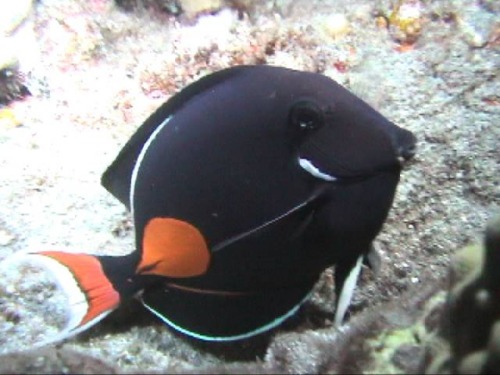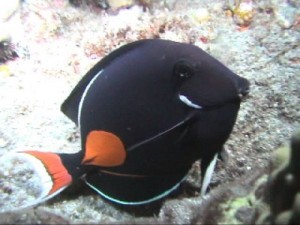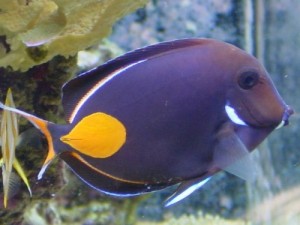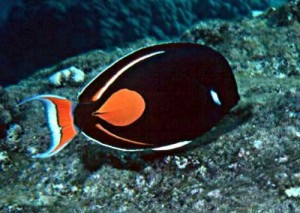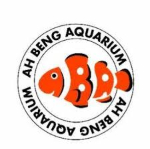Acanthurus Achilles Tang – The Most handsome tang in the Aquarium
Other Common Names: Achilles Surgeonfish.
Hawaiian Name: Pa-ku-‘i-ku-‘i
Scientific Name: Acanthurus Achilles (Shaw, 1803)
Identification
The Achilles Tang is no doubt one of the high sought after fish in this aquarium, as you can see from the photograph, the Achilles Tang is very distinctive with its black body, large bright orange spot, and other white and orange markings. Therefore, It is hard to mistake this fish for any other. It is a common fish found in Hawaiian waters, but the distribution of this species extends from Hawaii southward to central Polynesia and westward through Micronesia and Melanesia, but it apparently does not extend to the Philippine Islands, the East Indies, and the Indian Ocean.
Both adult and juvenile Achilles prefer to inhabit the oxygen rich waters in the shallower surge-zone area of the reef. They like rocky areas that have large cracks, caves and crevices to hide in. However, on one occasion we did find a small group of adults at a depth of 50-60 feet, and many times find juveniles residing in deeper waters outside the reef at depths of about 35-40 feet where they live amongst long finger coral.
Because of its close relation to the Goldrim Tang, this fish is usually found living with, or in the same vicinity as this species. On a few rare occasions, we have found Hybrid’s of this fish, a mix of an Achilles Tang and a Goldrim together, which makes them truly a unique and rare fish.
Keeping Achilles Tang in our Home Aquarium
The adults can grow to an average length of about 12 inches. Keeping a pair of AT can be challenging in a captive tank unless a nature pair can be obtained or else it may fight till it’s death. A tank not smaller than 4 feet is recommended for successful keeping of this fish, as it required plenty of swimming space in the open water with lots of flow.
Characteristics
The Achilles is highly sensitive to damage from even minor ammonia levels and poor water quality. It is a fish that is difficult to capture without damaging them. The Achilles’ skin is tender and easily scratched or marked. Its skin will show marks from any type of net, even a so-called “soft” net. Given good tank conditions, and the fish is untouched once placed in an aquarium, any minor surface marks will usually clear up within a week. When collecting this fish, the larger specimens have the nasty habit of “crashing” the net. That is swimming full force into it, then squirrelling around, up and down the net, stripping the skin off the area of their mouth. When purchasing this fish look closely at the nose area. If damage has occurred during collection and there are any raw or open sore areas on the body, this can be a site for potential infection.
The Achilles Tang is prone to contracting Ich (Whitespot Disease). If you want a good Ich warning system in your tank, the Achilles will do it. Ich will show up on the first, long before you notice it on your other fish. If ich is spotted, immediate treatment is of the utmost importance. Therefore it is highly recommended to properly quarantine your newly purchase fish from the local LFS.
Being in the Surgeonfish Family, this fish has sharp razor-like spur in the area where the body extends into the tail, do not get along well with other same or similar species, and needs plenty of room and hiding places!
Diet
This fish is a herbivore. Its main diet consists of marine algae, having an unusually long digestive tract to digest the plant matter they eat. They are constant feeders and in nature spend most of their day grazing. A habitat with algae growth is good for them, which in turn helps to keep the algae in an aquarium cropped and in check.
